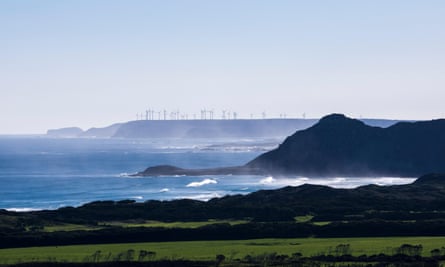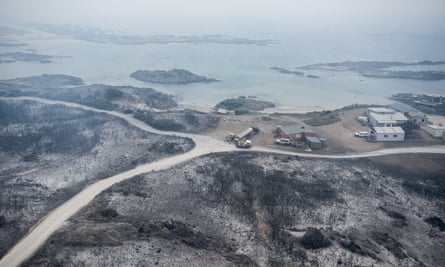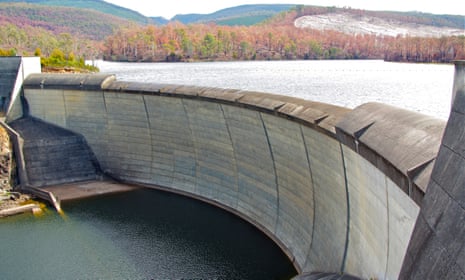The timing couldn’t have been any worse. On 20 December 2015, the undersea cable connecting Tasmania with mainland Australia malfunctioned, leaving the island state’s energy infrastructure stranded without help – just when it was needed most.
The bulk of Tasmania’s internal energy capacity comes from its extensive hydroelectric network but, with 2015 delivering the driest spring on record, water levels in the state’s dams were catastrophically low. More than ever, the Apple Isle was counting on electricity imported via the Basslink cable so that the hydroelectric dams could be given time to replenish.
Obscured by the Bass Strait’s silty seabed, the fault in the cable is yet to be identified, let alone repaired, and things are getting desperate.
Dam water levels are at 16.8% and falling, low enough that aquatic ecosystems are being put under strain. State-owned energy provider Hydro Tasmania had in December already reassembled and rebooted the old Tamar Valley gas-fired generators to ease the burden on the dams and is now spending $44m on importing temporary diesel generators with 200MW of capacity to help keep the lights on while the state waits for cables to be fixed or the rain to arrive.
Perversely, it is weather patterns consistent with climate change forecasts forcing Tasmania to return to the fossil fuels that likely helped generate the crisis in the first place. That would be the case even once the Basslink cable is repaired, as it will be Victoria’s brown coal-fired power stations providing Tasmanians with energy.

Thanks to its hydro network, the state is head and shoulders ahead of the rest of Australia in terms of renewable energy but that counts for little if the water runs out.
According to the Antarctic Climate and Ecosystems Cooperative Research Centre’s Climate Futures for Tasmania project, water catchment areas for the state’s dams are over the next century projected to experience increasingly severe rainfall shortages as coastal areas become subject to flooding due to warming oceans bringing El Niño weather events further south – just as happened in late January when the rain bucketed down in all the wrong places while the highlands were left dry. So dry in fact that bushfires, which continue to this day, swept through the area and forced sections of the state’s already strained energy infrastructure to be disconnected.
As a long-term solution, the Tasmanian government is awaiting a feasibility study due midyear into the prospect of creating a second Basslink cable and also has a sub-committee examining long-term renewable energy options.
Estimated to cost upwards of $1bn, having a second Basslink connected to the mainland would dramatically reduce the chance of being completely cut off again but the proposal has independent energy consultants concerned.
According to Phil Harrington, the Tasmania-based senior principal of carbon and energy at Pitt & Sherry, it would be difficult to demonstrate the net market benefit for such a project, suggesting instead that the money could be spent on expanding utility-scale wind power within Tasmania.
The state currently features roughly 310MW of wind capacity, well short of the average demand of around 1000MW.
Harrington says adding more wind farms into the mix would perfectly complement the existing hydro capacity.
“It’s a marriage made in heaven basically,” he says. “The dams act as a big battery so you don’t have to worry about the intermittency of wind and, in turn, there is the opportunity to capture wind farm power when the wind is blowing and reduce the draw on dams.”
Harrington notes that ramping up wind capacity would not just be beneficial in preventing the current crisis from repeating but could also bring long-term economic benefits by allowing the state to consistently export rather than import energy.
That’s without even factoring in the reduced carbon emissions that would result from in-house renewables as opposed to imported electricity from fossil fuel power plants.
There are several planned wind farm projects around Tasmania, including West Coast Wind’s 33-turbine Granville Harbour proposal, but an unfavourable legislative and investment climate has seen progress stall in recent years.

Harrington also advocates improving energy efficiency and lifting the solar feed-in tariff, which the Tasmanian government slashed by two-thirds in 2013.
Marc White, the principal consultant at Tasmania-based Goanna Energy consulting, wants to see an independent inquiry that considers all options – including the possibility of doing nothing at all.
“We don’t want any kneejerk reactions that result in overinvestment, given we’ve got spring inflows 50% below 30-year lows and Basslink failing, which have all conspired to hammer us,” he says.
White says it needs to be determined whether low rainfall levels are the new normal and also whether current energy consumption will be maintained into the future.
“We’ve got 60% of our energy consumed by five industries,” he says. The five major users of energy in Tasmania are Bell Bay Aluminium, Nyrstar, Norske Skog, Temco and Savage River mine.
“Are those five industries expected to be here in 50 years’ time?”
White agrees that hydro and wind complement each other up to a point but is uncertain whether incentivising households to take up rooftop solar would be the most cost-effective approach for the broader energy network.
“There are consequences [to rooftop solar] in regard to stranded energy assets,” he says.
“But I can see why people feel motivated to take control of their own destiny when they see the risks all around them.”
There were some small drops of good news late last week as the highlands, where the dams are located, received some rain. Not enough to significantly improve water stocks but perhaps the start of a recovery that can’t come quickly enough.
Plenty more is needed for a state that needs to save up not for a rainy day, but for the increasingly frequent dry ones to come.

Comments (…)
Sign in or create your Guardian account to join the discussion